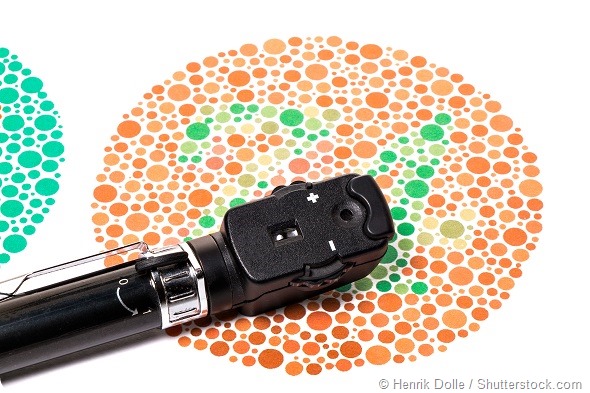An interview with Neil Retallic conducted by April Cashin-Garbutt, MA (Cantab)
What is color-blindness and how many people is it thought to affect?
Color blindness could be considered a bit of a misleading term, because there are very few people who can't see color at all. Most people have what we call color deficiency or color confusion, which means that they're not blind to color; they just see a reduced number of colors.
The first person to publish a scientific article on color blindness was an English chemist called John Dalton. That was in 1798 and the article was called Extraordinary Facts Relating to the Vision of Colors.
Basically, when we talk about color deficiency or color blindness, we’re talking about people who cannot tell the difference between certain colors, or, in extreme cases, can't see the color at all, which would be true color blindness.
Most research suggests that between 5 to 8% of males have color issues, but less than 1% of females do.

Is that the same across all countries?
Generally yes, as it's genetically linked. The most common statistic is probably about 8% of males or 1 in 12, and about 1 in 200 women.
In Britain, this means that there are approximately 2.7 million color blind people, so around 4.5% of the entire population – naturally, most of those would be male.
Are there different types of color-blindness? What are the underlying mechanisms at play?
To see color, light needs to enter the eye. On the retina at the back of the eye, there are specialized nerve cells called photoreceptors that take those signals.
There are two types of photoreceptors: there are the rods, which tend to deal with low or dark light and are more about black and white; and there are the cones, which are the main cells that deal with the color aspect.
There are three different types of cones, which respond to different spectrums of light. We tend to talk about light in wavelength, namely, short, medium, and long wavelength.
If someone's got an issue with color, it could be that one of those cones is completely absent, in which case they would have a more severe issue, or it may be that they've got the right cones, but they're just slightly deficient.
Total color blindness is very rare. People with that can only see black, white, and grey, which we call monochromacy. Basically, they can only perceive colors in brightness, but not the actual color.
It could be that there's a rod monochromacy, where the retina has no cones at all. There are actually some small groups of the population in certain islands where that's more commonplace.
Then there's cone monochromacy, where the retina has both rods and cones, but only one type of cone. People who suffer from this are able to see patterns well in normal daylight, but are not able to see the actual colors.
Then there are people who have the cones, but they're just not functioning very well. They can have red-green or blue-yellow color issues. These three types of that are dependent on whether it's a short, medium or long wavelength receptor.
So, there is total color blindness, where you've got quite a severe problem or there are just the mild problems, where you've got the cells to do the job, but they're not working 100% as they would when a person has normal color vision.
Why are men more likely than women to be color-blind?
It is a sex-linked trait. The defective gene is passed on through the X chromosome.
As men have an XY chromosome and women have two X chromosomes, it's men who are more likely to have it, because it's an X-linked recessive rather than dominant gene.

When is color-blindness screened for? Is it still tested for in schools in the UK?
At six weeks old, all babies tend to have a visit from a health visitor or GP. They won't necessarily screen for color vision at that point, but they will generally check that there doesn't seem to be any major issues with their vision.
If there was an issue, the baby would probably get referred straight to a hospital eye service to see an eye specialist.
The majority of schools no longer provide mandatory eye tests. If the school does, it's usually a nurse or an orthoptist seeing how well the child reads down a chart while asking them if they have any issues. They don't necessarily specifically screen for color.
Most of the time, color screening would be done when a child has its first eye examination with an optician or eye doctor, unless a child's mother or their teachers have noticed something they're a bit concerned about, in which case they may present them earlier than that.
Any child can have a free, routine eye examination with an optician/eye doctor under the NHS.

What options are available for color-blindness testing?
If a child presents to an optician/eye doctor, the optician will undertake further screenings – typically running the Ishihara test. This shows certain numbers within a pattern matrix and the child goes through the book and says what numbers they see.
The test is designed so that someone with normal color vision might give one number, someone who's got slightly different color vision perception will give another number, and there might be some cases where they don't see a number, whereas someone with normal color vision would see a number.
Then there may be someone who's got a color vision problem and would see a number, whereas someone with normal color vision wouldn't.
There are many screening tests. If the optician/eye doctor wants to get an idea of the severity, they may perform other color vision tests, which are arrangement tests.
The optician/eye doctor might give them what's called a D-15 or the 100 Hues test, where the child is asked to arrange the colors in order.
That gives a better idea of the type and the severity of the problem, since there are various different color vision deficiencies.
What kind of occupations can be affected by color-deficiencies?
Anything like aviation or the forces. As you can imagine, certain roles within those jobs require specific color vision.
There are other careers where color vision is very important, such as in the textiles industry.
Why is it important to diagnose color-blindness at a young age?
It's inherited and doesn't really change throughout life, so the sooner someone gets used to it and adapts to it, which they tend to normally do, the easier it is.
It can obviously affect children during their schooling and with everyday tasks - If it's quite severe, there may be confusion with activities we take for granted, such as matching a pair of socks.
It could potentially affect them in certain school subjects – art is an obvious one, but also chemistry or geography when they look at maps.
If an optician/eye doctor discovers someone had a color vision issue during testing, they would write a little letter or report for the school that would explain which things the child might confuse, which avoids frustration and provides an understanding as to how to better support the child in certain subjects.
It's also very important, because, in terms of career choices, it can avoid disappointment later down the line if a person has a color vision issue. If they wanted to go into a specific career, there may be restrictions; it might affect the level they could get in at, so it could be important from that point of view.
Research suggests that congenital color vision deficiency can affect educational achievement, so it definitely wise to screen children starting school.
Are there currently any treatments for color-blindness?
There are no preventative treatments as it's genetic. However colored filters, spectacles and contact lenses have been introduced that can alter someone's color perception.
They might allow the wearer to see a few more colors or colors nearer to how a person with normal color vision would see them, but it doesn't really solve the issue.
What research is being undertaken to further understand color-blindness and arrive at new therapies?
Some research has been done into gene therapy and there is certainly proof that they can improve color perception in animal studies, specifically with monkeys and mice, but it's whether that can be generalized across to humans.
One of the key studies was done at the University of California by John Hopkins Medical School. The researchers showed in a series of experiments that mice's color vision can be enhanced, but it's a case of whether that's going to be the same in humans.
Are there any other ways people can have issues with color other than color-blindness or deficiencies?
We actually see color because our brain interprets that light and then allocates a color to it.
Some people who obviously don't have color blindness or a color issue, still struggle at times with color, if they've got a migraine, for example. That would be partial color influences, not color blindness at all.
Migraine affects the vision and can affect color perception for that temporary period, but that's about a brain processing problem rather than an eye defect.
If you think about it, you've got almost three steps: you've got the light going in, the nerves interpreting that, the pathway through to the brain and then the brain interpreting that image and deciding what color it is.
For most people who have an issue with color, the problem is congenital and they've always had it throughout their life.
There are certain medical conditions that can lead to what we call an acquired color vision defect that's only come on because of a medical condition or later on in life.
Those conditions tend to affect more blue-yellow vision, whereas congenital problems tend to be affect the red-green vision more.
For example, if someone's diabetic or they have multiple sclerosis and optic neuritis, they would potentially have an acquired color vision defect. It can be a response to certain medication or just ageing in general.
The color perception can change, but that’s then what we would call acquired color vision deficiency rather than congenital.
What do you think the future holds for people with color-blindness?
A lot of people are not even aware they've got a condition or adaption, if you're talking about what you generally just call color vision deficiency.
If someone's told they're colorblind, then they will be aware of it and, like with any sensory issue, they just tend to adapt to it.
In the future, there may be some aids that become available that enhance things. For example, you can use better lighting or make use of technology, computers and electronic devices that often have settings or apps on them that can be changed to make them easier to use.
Apps may be introduced in the future that can help. There's certainly more and more awareness, support groups and just ways of adapting really.
Where can readers find more information?
A general place to get a lot of information is the internet, but you've got to be careful what you read and whether what you're reading has evidence-based research behind it to support any claims that are made.
There's a color blindness awareness site which is designed to raise awareness in the community: http://www.colourblindawareness.org/about-us/
Also, there is quite a bit of information on professional websites, where color vision is a clear requirement for certain career paths. That is certainly the case on the medical career website: www.colormed.com There are links that explain what the requirements tend to be for those careers, including in sectors such as aviation.
If somebody wanted more information just as a starting point, they could go and visit an optometrist or discuss it with another healthcare professional.
For more information on Vision Express, please visit: http://www.visionexpress.com/
About Neil Retallic
Neil Retallic, Learning and Development Manager-Registered Optical at Vision Express
Neil is a registered Optometrist who began working for Vision Express as an Optical Associate in 2004, whilst studying Optometry at the University of Manchester.
He completed his Pre-registration Optometrist training in 2006 to become a qualified Optometrist and joined Vision Express’ Support Centre team in 2010 as Optometry Development Manager, then became Optometry Operations Manager.
He is now the Learning and Development Manager-Registered Optical and is currently responsible for the professional development training programs, registered optical career pathway and professional trainee recruitment teams at Vision Express.
At the University of Manchester, he is an Optometry Teaching Fellow and Clinic Lead for the Final Year Contact Lens Clinics.
He is a visiting lecturer at Aston University, The British Contact Lens Association (BCLA) Education Adviser, vice chair of the British University of Contact Lens Educators (BUCCLE), and, an Examiner and Council Member for The College of Optometrists.
Since qualification, he has completed a postgraduate certificate in clinical optometry, professional certificate in low vision and has been awarded fellowships from both The British Contact Lens Association (BCLA) and The International Association of Contact Lens Educators (IACLE). He currently a committee member for various organizations include The College of Optometrists, The Optical Confederation and Manchester Local Optometric Committee.